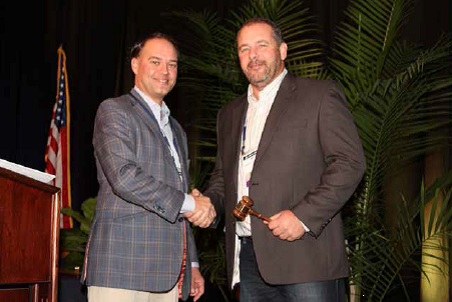|
Table of ContentsPOWTS Advisory Code Council Update NPCA Welcomes New Chairman (reprinted from Precast Inc.) Preventing Cement Burns (reprinted from Precast Inc.) | Upcoming Events
|
President's Message

Fellow WPCA members:
I thought I would take this time to introduce myself and the company that I work for. My name is Bruce Wieser. My wife Julie and I have three children, Ryan 27, Brandon 18, and Erin 16. I have lived in La Crescent, MN all my life. I graduated from the University of Wisconsin – La Crosse in 1994 with a degree in Business Administration. From riding in the truck with my father, to sweeping floors, to every aspect of the business, I have been involved with Al’s Concrete Products my whole life.
Al’s Concrete Products was founded my by grandfather in December of 1964. Septic tanks and dry wells were the main products that were produced back then. In 1973, my father Charlie bought the business from my grandfather. On May 4, 2015 my father passed away suddenly while getting ready for work. We had a succession plan in place but didn’t think we would have to use it so soon. Since then my brother Ben and I have taken over leadership of the company.
I always enjoy attending the WPCA conventions. This past winter convention George, Alison, and Heather hit it out of the park again. They put together a very informative conference. We had updates from OSHA, NPCA, POWTS Code Advisory Committee, POWTS Code and a crane rule update. It was great visiting with the vendors that exhibited at the convention. THANK YOU! THANK YOU! THANK YOU to the exhibitors, sponsors, and other associate members. With your support, we are able to keep dues affordable for our producer members. Your input and ideas are always very much appreciated. As producer members we need to keep our associate members in mind when looking at our purchasing decisions. I always enjoy talking with everybody at the conventions that we have and this convention was no different. It was nice to not only talk about what was going on in our businesses but also about the things that are happening outside of work.
We also learned at the convention that John Meade of Meade Construction Company and Steve Olson of Huffcutt Concrete have sold their businesses and are retiring. These two men have been an instrumental part of our association over the years. Both men have served as president of the association in the past and have given of their time and knowledge to help make the association what it is today. I along with the rest of the association wish them the best in the future.
Congratulations to Andy Wieser of Wieser Concrete for being named the new chairman of the NPCA at the 50th Annual Convention last fall. I think it’s pretty great to have one of our association members involved in such a vital role in the national association.
Moving ahead, crane certification continues to be a hot topic. Our association is in a holding pattern as far as offering training and testing like we did last spring. We are waiting hear from the NPCA as they are working with CCC instead of NCCO in developing a test that will be more in line with the cranes that precasters like us use. More to come on this issue in the near future.
In closing I look forward to serving as president of WPCA over the next two years. If there are ever any issues that come up in your part of the state that need attention please contact me or the WPCA office.
Bruce Wieser
WPCA President
Legislative Update
 On December 18, 2015, Gov. Walker signed SB 227 into law, which provides a sales and use tax exemption for contractors buying materials which will be used in a project for a nonprofit organization or local government municipality.
This new law will allow contractors to directly purchase construction materials on behalf of their tax-exempt clients without paying the sales and use tax. The law's effective date was January 1, 2016. This change helped fix a tax system that was unnecessarily burdensome, and caused supposedly tax exempt entities to indirectly bear additional unnecessary costs. The tax exempt pass through will apply to any building, shelter, parking lot, parking garage, athletic field, athletic park, storm sewer, water supply system, or sewerage and waste water treatment facility constructed for:
Project owners not covered by the new law:
The Department of Revenue (DOR) issued a January Tax Bulletin on how contractors, subcontractors and suppliers should implement and document their purchases for these tax exempt projects. Click here for a copy of the key pages in the DOR bulletin. The biggest question that the DOR has answered is that the new tax exempt material purchasing option is only available for projects that have an original contract between the tax exempt entity and the contractor that is signed on or after January 1, 2016. Change orders and separate contracts with suppliers and subcontractors by themselves do not qualify if the prime contract was signed in 2015 or earlier. A contract can be cancelled and renegotiated with a 2016 signing date. It is advisable to consult an attorney and tax expert before taking such an action.  George Klaetsch
|
POWTS Code Advisory Council Update
February 10, 2016 Meeting Update
The POWTS Advisory Code Council is actively reviewing several sections of the code and a few draft language provisions will be submitted soon for DSPS consideration. The types of changes involve:
- Procedural changes for electronic signatures (SPS 383.22 and 385.40(2)(b) 1. a.
- Frozen soil applications SPS 383.45(2)
- Create sand definitions and possible alternate mediums (new or experimental) used in a treatment or dispersal component. SPS 384.30(6)(j). This topic will affect our industry as the availability of “mound” sand and stone continues to become more expensive and harder to obtain.
- Wording and delays to the approval of Interpretative Determination Reports SPS 365.60(2)(a).
These types of topics have more of an indirect impact on our industry. The next topics however, will have an impact on our industry at some level.
Preventing Unauthorized Access
Let’s make every effort to be responsible to our industry and our customers for the safety and health of all that will be affected should an accident occur as a result of unauthorized access.
The debate continues over the different types of “effective measures” to ensure access openings remain locked or secured preventing unauthorized access to our tanks. Refer to SPS 383.52 (1)(a)2 and SPS 384.25 (7)(h).
The most common types of effective measures discussed is a chain or cable assembly which is anchored or securely fastened to the riser and the “open” ends of this assembly are secured with either a lock, quick link, or nut and bolt combination. In addition, plastic lids/covers are secured by means of a safety screw style or a standard “phillips” style screw.
Actual methods of securement have always been debated. For example: Is a nut/bolt assembly as effective as a lock? Is a “zip-tie” or nylon cable tie an effective measure of securement?
During any type of a maintenance procedure of a POWTS, it is common to experience one of the following conditions which prevents access:
a. The securing device is rusted or frozen closed.
b. Combinations not known or keys not available for locks.
To gain access, the chain or cable is “cut” rendering the “effective measure to prevent unauthorized access” useless when they leave. This is neither a smart nor a safe practice.
Considerations are being given to follow the established standards for a revision to the current code:
- ASTM C1227-13 (7.6.1) which states “…the lid shall weigh a minimum of 59 lb (27 kg) or be provided with a lock system to prevent unauthorized entrance.”
- NPCA’s Best Practices Manual On-Site Wastewater Systems states “…the concrete lid should weigh a minimum of 59 pounds (27kg) or be fitted with a lock system to prevent unauthorized entrance for materials other than concrete. Where access covers or lids are installed at grade, a secondary safety apparatus should be used in the event the cover is removed and not correctly secured.”
It goes without saying that measures are necessary to protect the safety and health of the public first and foremost. Ease of access, although a factor of time management for the service provider (i.e. pumper), should not be a concession to a standard which is intended as a safety measure.
- Do you think that the weight of a manhole cover is enough?
- Should the chain/lock assembly be eliminated?
- Just because a percentage of professionals choose to gain access by rendering useless the safety measure of a chain/lock assembly, is this reason enough to change the current code?
- Does the addition of a secondary safety apparatus (i.e. safety net type product) seem sensible and practical? Will the market/industry embrace or reject this added cost?
- Are there other ideas/concepts which have not been mentioned?
- Redundant measures is always a good practice when it comes to safety. Are we doing enough?
Existing Systems – Repair versus Replacement and is a New Permit Required
The basis for a new sanitary permit being issued for any repair or replacement of a POWTS component ensures that the County Sanitarian/Inspector is aware of the work and can inspect all work/repairs have been completed per code.
The questions/concerns that have been presented to date are:
- Does a repair really require any level of inspection?
- If a tank is replaced within the manufacturer’s warranty why another inspection?
- When a tank repair occurs to an existing tank, can the manufacture certify the repair?
- Why do simple repairs to floats and pumps in the pump tank need to be inspected?
- Can a section of pipe between tanks just be replaced or repaired? No changes to the installation.
The following sections are being considered for the when, how and the definitions of what a repair may or may not be. Throughout the codes, when the word repair is used, it is in context of; “the need for”, “accessible for repair”, “cannot be repaired”, “shall be repaired”.
SPS 284.25 POWTS holding components or treatment components.
SPS 382.22 Maintenance and Repairs – Specifically 382.22(2)(b) When a hazard to life, health or property exists…..that system shall be repaired or replaced.
SPS 381 Definitions. This section does not address what a “repair” may or may not include.
SPS 382.21 Testing and inspection and SPS 382.22 Maintenance and repairs.
There is nothing required of a repair other than an inferred compliance that a repair needs to meet the definitions of a new installation and all products must meet their product approvals.
The circumstance of a “tank replacement” should require an inspection to verify that nothing has changed from the original installation which would require a permit to drive this. What if the tank requires replacement and it is within the manufacturer’s warranty? Who would pay for the permit?
On a side note, the POWTS Technical Advisory Committee has all but one of the required appointed council members completed. The one position left to fill is a representative from the Academia sector. I believe there is a qualified individual who has applied and they are awaiting his or her appointment. Hopefully this committee will convene soon.
I look forward to your responses and will continue to provide updates as necessary to keep you informed of any changes. Thank You.
Bryon Wooten
POWTS Advisory Code Committee Chair
NPCA Welcomes New Chairman

Preventing Cement Burns
Evan Gurley is a technical services engineer with NPCA.
Reprinted with permission from NPCA (pages 8-10 of Jan/Feb Precast Inc.)
Cement burns can be harmful and sometimes disabling for exposed workers. For example, a recent Occupational Safety and Health Administration report cites an employee who did not follow the supervisor’s instruction to wear proper personal protective equipment on his feet. As a result, the employee
exposed his feet to wet cement. After noticing, the supervisor instructed the employee to wash his feet and change into the proper footwear required for the job. Later, the employee felt discomfort in his feet and had to be admitted to the hospital. By the time he arrived for treatment, he had sustained second- and third-degree burns on his feet. Employees who work with wet hydraulic cement and don’t follow safety precautions are at risk of developing skin problems ranging from mild and brief to severe and chronic.
CEMENT EXPOSURE RISKS
Hydraulic cement is hazardous to skin for a number of reasons, including its potential hydrogen concentration or pH. On the pH scale, which runs from 0 (very acidic) to 14 (very alkaline), cement has a pH of 12 to 13. Human skin is slightly acidic at pH 4 to 5.5. When skin is exposed to a higher pH substance, it becomes more permeable and easily absorbs chemicals. As a result, chemicals in cement can irritate the skin and even enter the bloodstream. Additionally, cement is abrasive and draws moisture from anything it comes into contact with, which as a result dehydrates skin.
If not properly addressed, these traits can cause skin issues for workers in precast concrete plants with prolonged exposure. Cement also contains trace amounts of hexavalent chromium, a toxin harmful to skin. Dry cement is less caustic and therefore less hazardous than wet cement, but it can still cause a wide range of harmful effects to the skin.
Four main skin problems encountered by workers who are exposed to cement on a regular basis include:
- Dry skin
- Irritant contact dermatitis
- Allergic contact dermatitis
- Cement burns
Dry skin
Workers not following safety procedures often experience dry skin, which can be accompanied by redness, itching and other unpleasant symptoms when working with cement.
Irritant contact dermatitis
Skin contact with wet cement can also cause inflammation, referred to as dermatitis. Signs and symptoms of dermatitis can include pain, itching, redness, swelling, blisters, scaling, scabs and other changes in skin’s normal condition. Irritant contact dermatitis, a non-allergic form of dermatitis, is related to the caustic, abrasive and drying properties of cement. ICD can be short term or chronic.
Charles Piwowarski, area environmental manager with Forterra Building Products, said the best way to address potential dermatitis skin issues is by asking basic questions:
- Are employees being hygienic? This includes washing contacted skin, not staying in soiled clothing for long periods of time and using a preoperational barrier cream.
- Is the plant providing soap with warm or hot water in the washrooms?
- Is the form oil contaminated? In some instances, the form oil may become contaminated with water, cement dust or other impurities. Be sure to inspect your form oil (totes, sprayers, tanks) and be suspect to changes in color and viscosity.
Some employees may be prone to dermatitis even with the above
precautions, so it may be necessary to relocate an employee to another area of the plant to reduce or prevent exposure.
Allergic contact dermatitis
The hexavalent chromium in cement can cause allergic contact dermatitis, an allergic reaction form of dermatitis, in sensitized employees. When an employee is sensitized, the immune system overreacts to small amounts of hexavalent chromium, which can lead to severe inflammatory reactions after subsequent exposures. Sensitization may result from a single exposure, from repeated exposures over the course of months or years, or it may not occur at all. After an employee becomes sensitized, which can last for years, brief skin contact with very small amounts of hexavalent chromium can trigger ACD. This condition includes many of the same symptoms as ICD, but is difficult to cure.
Cement burns
If left on the skin long enough, wet cement can cause caustic burns, referred to as cement burns. Cement burns may result in blisters, dead or hardened skin, or black or green skin. In severe cases, burns may extend to the bone and cause disfiguring scars or disability. Employees cannot rely on pain or discomfort to alert them to cement burns, as immediate pain or discomfort may not occur. Cement burns can get worse even after skin contact with cement has concluded.
National Precast Concrete Association and OSHA recommend any employees experiencing cement burns see a health care professional immediately.
OSHA STANDARDS APPLICABLE TO WORKING WITH CEMENT
Several OSHA standards require employers to take steps to protect employees from hazards associated with exposure to cement. These standards include requirements for:
- Personal Protective Equipment (29 CFR 1910 Subpart I for general industry)
- Sanitation (29 CFR 1910.141 for general industry)
- Hazard Communication (29 CFR 1910.1200 for general industry)
- Recordkeeping (29 CFR 1904)
- Permissible Exposure Limit (CFR 1910.1000 for general industry)
The best way to prevent cement- related skin problems is to minimize skin contact with wet cement. Compliance with OSHA’s requirements for equipment, washing facilities, hazard communication and safety training, along with good skin hygiene and work practices, will protect against hazardous contact with wet cement at precast concrete plants.
| Return to Top |
|
|
Wisconsin Precast Concrete Association |

 Building Materials Tax Exemption Signed Into Law – Possible Benefits to Precast Manufacturers
Building Materials Tax Exemption Signed Into Law – Possible Benefits to Precast Manufacturers